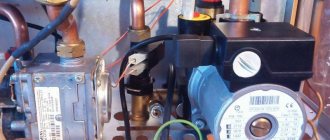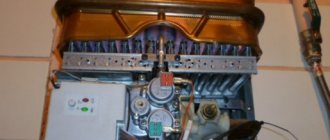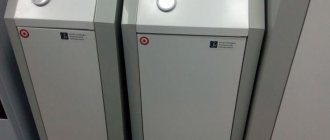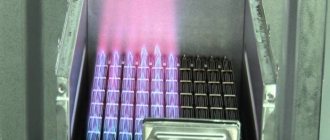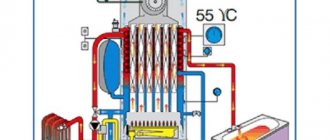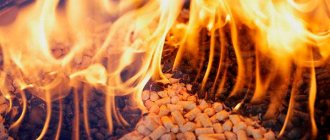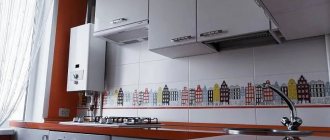This year I celebrated Christmas with my friends who live in a private house outside the city. January turned out to be frosty. The air temperature outside the window, on this frosty evening, stubbornly strived for 30 degrees. And everything would have been fine if the gas boiler in the house had not turned off a couple of hours before midnight. Agree that being left without heat on a frosty night is not a pleasant pleasure. Naturally, the question arose about the reason for the failure of the gas boiler. We will talk about what causes a malfunction of a gas boiler in this article.
Gas boiler malfunctions
It turned out that the boiler had gone out and did not want to start. According to safety rules, repairs to a gas heating boiler must be carried out by qualified specialists. However, in some cases, when the arrival of a specialized repair team can be expected for a very long time, you can repair the boiler yourself. Let's look at the main reasons when a gas boiler does not work.
The main symptoms of a gas boiler malfunction are
- the boiler does not start;
- burner extinguishment;
- the gas boiler does not reach temperature;
- the boiler does not turn off.
Gas boiler does not start
If the gas boiler does not start, the reasons may be the following:
- the electronic or manual ignition system has failed;
- there may be no voltage in the electrical network;
- interruption of gas supply or closed valve on the supply pipe;
- insufficient or excessive gas pressure in the network;
- burner nozzles clogged.
Repair or replacement of the ignition system and cleaning of burner nozzles must be carried out by specialists with special approvals from supervisory authorities. Damage to the nozzle holes during cleaning can subsequently cause such a phenomenon as the flame tongues coming off the burner, which leads to automatic shutdown of the boiler.
A lack or excess of gas pressure in the network can be caused by a malfunction of the fittings, gas meter, etc., and a gas company specialist can also find out the exact cause.
Gas boiler burner extinction
Possible reasons for the burner to go out during operation or immediately after switching on, that is, when the gas boiler does not ignite, may be the following:
- insufficient, excessive or reverse draft;
- the traction sensor is faulty;
- poor thermocouple contact;
- power outages or surges in the network to which the volatile boiler is connected;
- depressurization of gas supply pipeline connections.
Reasons related to draft apply to boilers with an open combustion chamber and a natural exhaust gas removal system, although the effect of blowing out the burner flame by gusts of wind can also occur in coaxial chimneys. All modern boilers are equipped with draft sensors, which are triggered when there is insufficient draft, after which the automation extinguishes the burner. If there is excess draft, the rate of exhaust of combustion products increases, which causes the flame to blow out of the burner; in this case, the automation also cuts off the gas supply. Backdraft or air blowing through the chimney can occur during strong gusts of wind, and the flame in the burner goes out.
Diagnostic procedure for an atmospheric boiler. The principle of traction control.
In the atmospheric version of a gas boiler (with an open combustion chamber), combustion air is taken from the room. That is why for such boilers it is necessary to ensure normal air flow in the place where it is installed. To control draft in such boilers, a safety thermostat is often used. In atmospheric boilers, a draft stabilizer is used - this is a structural element of the boiler located above the burner, which is needed to ensure stable combustion and a dosed supply of secondary air. The safety thermostat is located on this stabilizer and reacts to temperature. If, when a gas boiler is burning, the draft is reversed (air from the chimney goes into the room, and not vice versa), the sensor will inevitably be heated by the exhaust gases and the operation of the boiler will be stopped.
Problems with smoke removal in atmospheric boilers may be due to design errors, clogged chimneys, lack of normal air flow or operation of exhaust devices. The use of such boilers within the range of additional exhaust devices is in principle not permitted.
To summarize, to diagnose a malfunction in the atmospheric version of the boiler in the event of a draft error, the following is required:
- Make sure that the air flow in the room and in the boiler is not blocked - the boiler is not overgrown with dust.
- With the equipment turned off, check that there is natural draft in the chimney and that it is directed out of the room. Experts can measure the amount of draft accurately with a device (special holes are provided in the boilers), the user can only “by eye”, by feeling, with a burning match or a strip of paper, etc. Often, boiler owners are convinced in advance that everything is fine with the draft! The probability of a control board malfunction for a traction error tends to zero! The reasons for blocking the chimney can be different: birds, spiders, dirt, ice, etc.
- Checking the serviceability of the thermostat (traction control sensor). The technique for most boilers is described above. The sensor in most cases is a bimetallic strip and has two positions: closed and open.
Problems with draft in a gas boiler
To identify malfunctions of a gas boiler, it is necessary to check the lack of draft with the combustion chamber open. To do this, you need to bring a lit match to the holes through which air from the room enters the atmospheric burner. If the draft is normal, the flame should be directed inside the body and burn evenly.
Excess draft can be determined by too intense combustion of gas, as a result of the humming of a gas boiler, while the color of the burner flame becomes very light, almost colorless. If you bring a lit match to the air intake, its flame will immediately go out.
Problems with draft arise due to non-compliance with the rules during the construction and operation of chimneys, their insufficient height above the roof or, conversely, too high a height, violation of the tightness of the metal part of the chimney, or foreign objects entering the chimney. Another reason for traction failure is when condensation forms on the pipe of a gas boiler. This occurs due to the fact that hot water vapor present in the exhaust air rises through the chimney and gradually cools, causing condensation droplets to fall out. During the cold season, condensate freezes, which leads to icing and a decrease in the clearance of the chimney channel.
Gas boilers Keber characteristics, faults and reviews
The boiler can turn off spontaneously for several reasons. This usually occurs due to a faulty combustion sensor. This problem, in turn, most often results from contamination of the gas pipe. Remove the pipe, rinse it thoroughly with water, clean it with a cotton swab and blow off any remaining moisture.
Return the pipe to its place and try to turn on the boiler. If it doesn’t help, call a specialist. Of course, any equipment can fail. Keber boilers are no exception. Let's look at the most common problems that owners of such equipment have to face:. To summarize all of the above, it is worth saying that the Keber gas boiler is an effective heating device.
User reviews indicate that the unit is economical, easy to use and has a long service life. Let's look at the example of Hydrosta HSB. They look like this:. These mechanisms have the same characteristics as the wall-mounted options, but they are characterized by higher performance and additional functionality:. South Korean gas boilers from Hydrosta, like Daewoo, operate on diesel fuel and gas, automatic double-circuit, designed for heating rooms up to square meters and supplying them with hot water.
The fuel burns almost completely thanks to the turbocharged burner used. The automation itself maintains the specified temperature conditions of air and water.
All models are equipped with double protection against overheating, against freezing and control of the flame in the combustion chamber. The boilers allow you to connect a gas leak sensor - it is carried out in a remote version and allows you to remotely monitor the gas condition in the heated room. If a leak is detected, a sound signal and light indication are given, and the gas supply is immediately cut off.
How to solve craving problems
What to do if the gas boiler blows out or there is insufficient or excessive draft in the chimney? Traction problems can be resolved on your own. First of all, find out the nature of the violations, and then increase the chimney if there is insufficient draft or reduce its length if there is excessive draft, clean it from blockages and ice. Also, using soapy water, you can independently determine where the metal parts of the chimney are depressurized and insulate them.
A malfunction of the draft sensor can be easily determined in the following way - the sensor terminals must be short-circuited and try to ignite the boiler burner. If the boiler starts working, it means the sensor is faulty and needs to be replaced.
In order to prevent the boiler from shutting down due to possible power surges for volatile boilers, it is necessary to install a stabilizer on the supply electrical networks that equalizes such surges. One of the reasons for the extinguishing of the burner flame immediately after switching on is poor contacts of the thermocouple, which is present in the automation of all boilers. You can clean the thermocouple contacts yourself.
Gas boiler does not reach temperature
If the gas boiler is working, but the coolant temperature does not reach the required level, the reasons may be the following:
- insufficient air flow necessary to maintain the normal combustion process. When operating boilers with an atmospheric burner installed in combustion chambers, there must be holes or grates at the bottom of the doors leading to these rooms;
- problems with draft due to an improperly constructed chimney or its clogging;
- malfunctions of the boiler itself - the circulation pump does not work, individual automation elements have failed;
- the pressure in the heating system has dropped due to depressurization, insufficient coolant volume, clogging of pipelines with dirt particles, mineral deposits;
- air pockets in heating devices;
- if the boiler is double-circuit, the hot water supply system takes too much energy.
Some gas boiler malfunctions, such as draft problems or lack of air flow, can be corrected yourself. But it is better to entrust the solution to other problems related to the operation of the boiler equipment and heating system itself to specialists.
The gas boiler is ticking, what should I do? — Handyman's Handbook
Today, gas heating boilers are the most common devices for heating homes. Choosing the right boiler based on power and other necessary criteria will help you avoid many problems in the future.
The following functionality is usually considered as selection criteria:
- Heating circuit diagram. The subsequent choice of the boiler depends on the choice of the type of circuit, which may be energy dependent or will not require electricity for its operation.
- Single-circuit or double-circuit boiler. You need to decide to purchase a separate indirect heating boiler or a double-circuit boiler.
- Combustion chamber type. They are open or closed. Popular wall-mounted boilers usually have a closed chamber and a coaxial chimney. To effectively remove combustion products, a forced draft fan is installed. For open circuits with non-volatile boilers, a chimney with good natural draft is needed to operate the open combustion chamber.
- Selecting the boiler type. Depending on the area of the premises and the heating scheme, the type of boiler selected is wall-mounted or floor-standing. Typically, for rooms with an area of more than 300 m2, a floor-standing boiler is installed.
Why does my gas boiler keep switching off? Causes and solutions
The gas boiler system is responsible for several functions - heating the room, providing hot water supply. Sometimes, during the coldest period, a malfunction may occur, leading to equipment shutdown. An unpleasant situation most often occurs during the heating season, so in order to eliminate the breakdown as quickly as possible, you need to know the main causes of the breakdown.
Reasons for frequent switching on and off of a gas boiler
It happens that a new installed device, after configuration and commissioning, begins to turn on and off too often. Although such a device should automatically regulate its operation, such a process clearly indicates a failure in the system. This can have a detrimental effect on the life of the device, because the working elements begin to wear out quickly, and the device itself will fail.
Self-extinguishing burners is the main malfunction of gas boilers
There are reasons why a heated boiler fires quite often. In any case, it is better to contact a specialist if you lack professional experience, because you need to be careful when manipulating blue fuel. The main reasons for turning heating equipment on and off at frequent intervals:
- incorrect device selection. The power is provided for a large room, and the unit was installed in a small room;
- incorrect installation of the circulation pump;
- the temperature range is incorrectly set;
- There is no thermostat in the room, for this reason the operating state of the device is adjusted according to the temperature readings of the coolant.
Important! This problem is quite simple, but there are times when the device has to be replaced with another model
Problems of open-type atmospheric boilers
There are a number of reasons that affect the working process of the device, which worked properly for some time, and then suddenly begins to go out.
Traction problems
To check the device for this problem, bring a lit match to the main window. If there is draft, then the fire will deviate to one side; if there is no draft, the flame will burn evenly.
Checking draft in a gas boiler
The main factors influencing traction disorders:
- Lack of proper ventilation. The air intake is carried out from the room; a window is required for ventilation. Natural ventilation is required to maintain the flame. You must open the window to resume operation of the device.
- Weather. Adverse weather conditions negatively affect the working process of the chimney. If a foreign object gets into the shaft, backdraft may occur, leading to carbon monoxide poisoning.
- Ice formation. The accumulation of condensate on the shaft walls leads to icing of the part, and consequently a barrier is formed for normal draft and smoke removal. This reason must be eliminated in the following way - knock off the frozen layer, insulate the walls of the mine.
- Sooty accumulation. Simultaneously connecting a gas appliance and a solid fuel model leads to a similar problem. In this situation, it is better to resort to the help of utility services.
- Pipe burnout. The part must be completely replaced.
Gas boiler does not turn off
In some cases, malfunctions of heating equipment consist in the fact that the gas boiler does not turn off. Gas boilers, whose operation is regulated automatically, turn off when the room temperature reaches a set value. The temperature regime is determined using a thermostat installed in the unit, and the boiler is turned off by a processor built into the electronic control board. If the boiler does not turn off, it means the board or thermostat has failed.
There are some other problems with heating equipment, for example, when a gas boiler knocks. This can happen for various reasons - when debris gets into the combustion chamber through the chimney, when other liquids are used instead of water as a coolant, air locks in the system, low pressure. In any case, it will be difficult to independently determine the cause, so you should contact a company that services gas equipment.
AOGV 11.6-3 Rostov, burner does not turn off
Olegh wrote: It would be very nice.
The thermocouple is a copper or brass tube. One end is screwed into the fitting on the regulator body and has a nut on it to seal the gasket. At the other end of the tube, inside, a sleeve with internal thread is installed, and the end of the tube itself is welded. A cylindrical INVARIC ( an alloy of nickel and iron) rod. The other end of the Invar rod passes into the regulator body and rests against the shaped lever in its upper part. The thinner part of the rod entering the body is sealed with a rubber bushing. A spring acts on the bushing through a washer. The rod visible in in the window formed by the tides on the body of the regulators, a clamp is put on. It is fixed to the rod with a screw and has a bent pointer end that extends outward, outside the window. When the main burner is not working, the water in the tank begins to cool and, consequently, the temperature of the thermoelement tube decreases. The tube will begin to shrink and its free end will move to the right. The Invar rod located inside the tube has very low thermal expansion, and when cooled, its length practically does not change. Therefore, as the free end of the tube moves to the right, inv. the rod also moves to the right, increasing its pressure on the figured lever, and when a certain temperature of the water in the tank is reached, the moving system is thrown to the extreme right position. If the regulator is in the “OPEN” position (the moving system is in the extreme right position), then the hook of the shift lever enters into the hole of the valve seat and pushes the valve away. The valve moves away from the seat to the right and compresses its spring. The gas enters the burner and ignites from the igniter. When the burner operates, the water in the tank heats up, the tube lengthens, its free end moves to the left. As the temperature rises and lengthens tube, the pressure of the injection rod on the figured lever decreases and disappears at a certain temperature, but before that the valve spring will unclench, the valve will push the pericid lever, rest against the seat and shut off the gas, and the movable system will work to the left. Turning off the burner will lead to the cooling of the water in the tank, and therefore, to a new activation of the system. In this way, the burner is periodically ignited and extinguished, which ensures a constant temperature of the water in the tank. A working regulator maintains the temperature within 3-5 degrees. The water temperature is set and changed by moving the Invar rod. To increase the temperature, the rod is unscrewed (thread right), to lower it is screwed in. The rod is rotated using a fixed clamp, holding it by the bent end-pointer to a certain angle. The maximum angle is 70 degrees. It is limited by the tides forming the window. If this rotation is not enough, then loosen the clamp and intercept again. Rotate the clamp at 70 degrees adds about 12 degrees C. The thread has 14-15 threads, which allows you to adjust the temperature within 40-90 degrees.
What to do if gas pressure drops
In our case, the gas pressure dropped. This happened due to the formation of ice in the pressure reduction valve, which was located in an iron box on the street. The reason was a sharp temperature drop from zero (it was raining) to minus thirty. I had to open the gas supply valve a little to increase its supply. Naturally, we violated the gas supply regulation, but in an emergency, this was the only way out.
Let me draw your attention to the fact that before turning the knob, you must note its previous position. After the boiler’s operation was restored, I had to use a hairdryer to warm up the fittings in the box. Naturally, after the obstacle has been removed, it is necessary to return the handle to its original position, thereby restoring the gas supply setting.
The reasons for a malfunction of a gas boiler can be very different. Knowing the symptoms of a particular malfunction, you can always find the right solution. In the next article I will tell you how to build a chimney for a fireplace.
I RECOMMEND ALSO READING:
